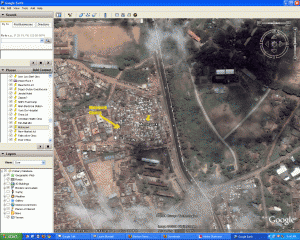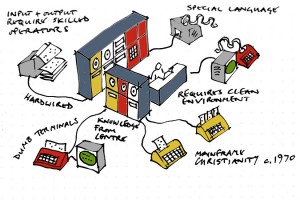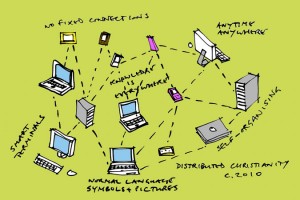Finished “Reimagining Church” last night. A good followup to Frank Viola’s book “Pagan Christianity” The book picks up in many places where Pagan Christianity left off – but also works as a standalone piece as well. As the summaries and publishers suggest, Pagan Christianity deconstructs the church and Reimagining reconstructs it.
Don’t know if it fully reconstructs it – but it definitely get’s the ball rolling.
Viola explains in the introduction:
Herein lies the purpose of this book: to articulate a biblical, spiritual, theological, and practical answer to the question, Is there a viable way of doing church outside the institutional church experience, and if so, what does it look like?
Many could see Viola as a threat to the church – especially the institutional church – but perhaps that’s why I really enjoy the book. He adds in the introduction, “I’m writing this volume because I love the church very much.” It’s the institution that he (and I tend to) have problems with. (Viola later suggests that “institution is any patterned human activity.”)
Viola argues that the institutional church as we know it is ineffective and also without biblical merit. That our current churches are constructed more on programs and rituals than relationships. That institutional churches are built around a highly structured “worship service” where the audience is separated or set-apart from the professionals (pastors, ministers, worship leaders, etc.).
In the institutional church, congregants watch a religious performance once or twice a week led principally by one person (the pastor or minister), and then retreat home to live their individual lives.
In place of the institutional church (which Pagan Christianity explains came about through many Greco-Roman customs — especially during the Constantine era), Viola argues for a more organic approach to Christianity. One in which there is no separation between lay-persons and the clergy. One in which each person’s spiritual gifts are valued and each person takes part in the group gatherings. One that meets in homes during the week rather than multi-million dollar sanctuaries/malls.
Viola compares these two views of church throughout the book, but perhaps the most beautiful illustration is one from Hal Miller.
Miller says that institutional churches are like trains. They go a certain direction and continue on that direction making a lot of noise and blowing a lot of smoke. They’re easy to find, hard to stop and can’t change direction without coming to a crawl and someone flipping the switch on the track.
Organic churches are more like people walking through a neighborhood. They move much slower but can turn at a moment’s notice. Because of their slow pace they can be genuinely attentive to the world around them, as well as to the Lord.
And because of it’s organic nature, the organic church is always growing and reproducing. And no matter where it grows or shows up, this organic church should always reflect the same DNA elements ::
- It will always express the headship of Jesus Christ in His church
- It will always allow for and encourage the every-member functioning of the body
- It will always map to the theology that’s contained in the New Testament
- It will always be grounded in the fellowship of the triune God
Those first two points are probably the stickiest points for everyone and likely why Viola spends a vast majority of the book discussing them. Unfortunately, I felt like he spoke more on what that didn’t look like than what it did look like.
In addressing these issues, Viola argues that the body of Christ must not be about the hierarchy systems of the world but must instead be about mutual edification and mutual submission. I personally believe this is a lot of what Christ spoke of in John’s 1st letter ::
I’m praying not only for them
But also for those who will believe in me
Because of them and their witness about me.
The goal is for all of them to become one heart and mind—
Just as you, Father, are in me and I in you,
So they might be one heart and mind with us.
Then the world might believe that you, in fact, sent me.
The same glory you gave me, I gave them,
So they’ll be as unified and together as we are—
I in them and you in me.
Then they’ll be mature in this oneness,
And give the godless world evidence
That you’ve sent me and loved them
In the same way you’ve loved me. (john 17)
Imagine the impact this would have on the world around us if we all truly lived as one. Where no one person took precedence, where church decisions were based on consensus rather than dictatorship or democracy. If the members of Christ’s body are truly submissive to Christ and to one another, I believe Viola would argue that this would turn the world upside down.
Yet for someone who’s grown up in a traditional, institutional church, the idea of a church led not by a man (or woman or group of men) but by the headship of Christ (through the Holy Spirit) is foreign. And yet I can definitely understand the reasoning behind it. I can agree with the Scripture Viola uses to make the point — but to picture it and understand how you would bring that about is foreign to me (and probably 99% of “church-going Christians). Perhaps this will be addressed in future books.
It does look as though this is part of several more in the “series” as Viola mentions two more books coming out in the near future. “From Eternity to Here” is the next one on the map.
Regardless, this book leaves me hungry for seeing something more in our churches today. It’s a great supplement/compliment for what I’m feeling/thinking/dreaming in my soul. It leaves me aching for truer community, where there are true spaces of grace, intentional relationships and God experiences are shared by all.
I hope to come back and share some of the many quotes/thoughts that stood out to me in my reading — but I just started a new book by Greg Garrett, “Stories from the Edge – A Theology of Grace” so it might take me a week or so to get back to “Reimagining Church” :-).
related ::
www.reimaginingchurch.org
www.housechurchresource.org
www.ptmin.org
SSL :: looking back at a house of prayer
encounter :: priests in the hood
encounter :: tribal faith
Like this:
Like Loading...


